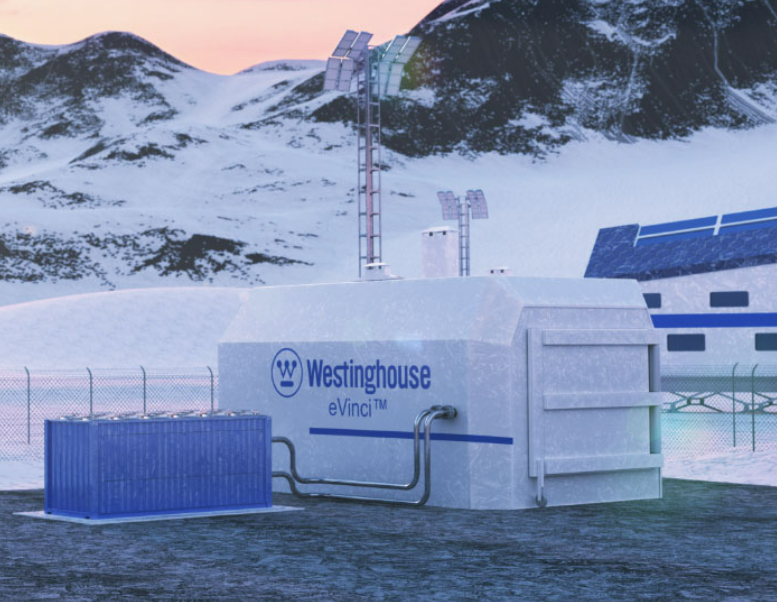 Westinghouse's eVinci micro-reactor (Source: Westinghouse).
Westinghouse's eVinci micro-reactor (Source: Westinghouse).
The governments of Ontario, New Brunswick, Alberta and Saskatchewan released a strategic plan providing a path forward to advance small modular reactors (SMR) in the country.
SMRs are expected as the next evolution in nuclear innovation and technology. Their benefits are linked to the nature of their design – small and modular. SMRs can be sited on locations larger nuclear power plants cannot be. Prefabricated units of SMRs can be manufactured before being shipped and installed on site, making them more affordable than large power reactors.
The provinces’ plan outlines five priority areas for the development and deployment of SMRs:
1. Technology readiness: The strategic plan notes Canada’s early adoption of SMRs would position the country as a global nuclear technology hub, jumpstarting new economic and job growth through three SMR development streams:
Stream 1: a 300 MW SMR project constructed at the Darlington nuclear site in Ontario. In December 2021 we reported that Ontario Power Generation (OPG) selected GE Hitachi Nuclear Energy (GEH) to supply a BWRX-300 SMR for the site. The project could be completed as soon as 2028.
The strategic report adds that subsequent units in Saskatchewan would follow, with the first of those SMRs projected to be in service in 2034.
Stream 2: two fourth-generation, advanced SMRs would be developed in New Brunswick. ARC Clean Energy is targeting a deployment date by 2029, with Moltex Energy aiming to have both its spent fuel recovery system and reactor in operation by the early 2030s, both at the Point Lepreau nuclear site. ARC and Moltex Energy, along with New Brunswick Power, partnered in 2020 as part an SMR vendor 'cluster' at Point Lepreau, which currently houses a 660 MWe Candu 6 reactor.
Stream 3: a new class of micro-SMRs designed primarily to replace the use of diesel in remote communities and mines. Ontario Power Generation (OPG) and Seattle-based Ultra Safe Nuclear are combining on a five MW gas-cooled demonstration micro-reactor at Chalk River, Ontario, with plans to be in service by 2026. Global First Power estimated that one MMR could replace 200 million liters of diesel at a mining site over 20 years.
The report also notes Bruce Power and its partners at the Nuclear Innovation Institute have also been exploring opportunities with the Westinghouse Canada eVinci micro reactor. In October 2020, Bruce Power and Westinghouse agreed to pursue applications of eVinci, with initial deployment in Canada targeted for the mid-2020s.
• Regulatory framework: The strategic plan noted regulatory changes and clarity will be needed to ensure reasonable project costs and timelines for investor and operator approvals.
• Economics and financing: The plan calls for a robust federal funding commitment to continue advancing SMR development and deployment. It notes the growth of SMRs in Canada and around the world will drive increased uranium demand, providing new opportunities for uranium produced in Saskatchewan and potentially Alberta, and increased utilization of refinery and conversion facilities in Ontario.
• Nuclear waste management: According to the plan, the Nuclear Waste Management Organization (NWMO) is working to identify a geologic storage depository for Canada’s used fuel waste. The provinces said twenty-two communities initially expressed interest to host the site and two potential sites in Ontario are still being considered, with safety assessments and community engagement ongoing. The NWMO is planning to select a single preferred site in 2023, with operations expected to begin between 2040 and 2045.
• Indigenous and public engagement: The plan emphasizes the need to create opportunities for Indigenous communities to participate in SMR projects. These opportunities could include employment, skills development, investments, or supplier arrangements.
As the general nuclear landscape goes, Canada currently has close to 20 commercial reactors generating about 13 GW in capacity, dominated by its home-grown CANDU design. According to the World Nuclear Association, about 15% of Canada’s electricity comes from nuclear.
